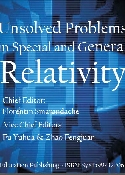Unsolved Problems in Special and General Relativity
von Florentin Smarandache, Fu Yuhua, Zhao Fengjuan (Editors)
Unsolved Problems in Special and General Relativity
21 collected papers
Chief Editor: Florentin Smarandache
Vice Chief Editors: Fu Yuhua & Zhao Feng
Copyright 2013 by Education Publishing & Journal of Matter Regularity (Beijing)
ISBN: 9781599732206 – Printed in the United States of America
Preface
This book includes 21 papers written by 23 authors and co-authors. All papers included herein are produced by scholars from People’s Republic of China, except two papers written by Prof. L. Sapogin, V. A. Dzhanibekov, Yu. A. Ryabov from Russia, and by Prof. Florentin Smarandache from USA. The editors hope that all these papers will contribute to the advance of scholarly research on several aspects of Special and General Relativity. This book is suitable for students and scholars interested in studies on physics.
The first paper is written by Hua Di. He writes that Einstein’s general theory of relativity cannot explain the perihelion motion of Mercury. Einstein’s explanation, based on wrong integral calculus and arbitrary approximations, is a complete failure.
The following paper is written by Li Zifeng. His paper reviews basic hypotheses and viewpoints of space-time relationship in Special Relativity; analyzes derivation processes and the mistakes in the Lorentz transformation and Einstein’s original paper. The transformation between two coordinate systems moving uniformly relatively to another is established. It is shown that Special Relativity based upon the Lorentz transformation is not correct, and that the relative speed between two objects can be faster than the speed of light.
The next paper is written by Li Wen-Xiu. His paper presents problems with the special theory of relativity (STR), including: (1) The principle of relativity as interpreted by Einstein conflicts with the uniqueness of the universe. (2) The light principle conflicts with the notion that natural phenomena depend only upon mutual interaction and the involved relative motion. The principle contains a tacit assumption that leads to self-contradiction.
The next paper by Shi Yong-Cheng says that Einstein’s book “The Meaning of Relativity” contains of a supper mistake which leads to the famous twin “paradox”.
The following paper by Xu Jianmin proposes the assumptions of radiation and redshift, establishes the quantum gravitational field equations and motion equations, and presents that particles move along the path with the minimum entropy production. The paper also applies the equivalence principle of acceleration and the gravitational field into the electromagnetic field, which makes the electromagnetic field equation to have the same form with gravitational field equation.
The next paper is written by Dong Jingfeng. By the analysis of twin paradox, it is pointed out that the constriction of space-time is the only effect of measurement and all paradoxes do not exist actually. The essence of special relativity is a number method for ways to provide math and physical idea.
The following paper is written by Duan Zhongxiao. Through comparing the two Lorentz transformations located at different regions, the author finds that for two inertial systems running the relative uniform speed translational motion, if two clocks are synchronous in one system, they are also synchronous looked from another system; this means that the relative character of simultaneity is not the ultimate source of temporal and spatial transformation. Thus we know that it is wrong to introduce the one-way spreading light signals along with all directions in space into transformation.
Fu Yuhua writes the next paper. He says that special theory of relativity and general theory of relativity have three basic shortcomings. First, the special and general theory of relativity respectively have two basic principles, altogether have four basic principles in the v interior of relativity, these obviously do not conform to the truth uniqueness. Second, for the two basic principles of special theory of relativity and the two basic principles of general theory of relativity, no one is generally correct. Third, establishes the physical theory from the mathematics principle instead of the physical principle. Based on these, the applicable scopes of special and general theory of relativity are presented.
Guo Kaizhe and Guo Chongwu write the following paper. They write that there are magnetic field forces between positive charge and negative charge in an electric dipole which is moving in a laboratory reference frame. Whereas, examining the electric dipole in a reference frame which is at rest relative to the electric dipole, we find no magnetic field force exists between the two charges.
The next paper is written by Guo Ying-Huan and Guo Zhen-Hua. They write that by carefully comparing the results given by the general theory of relativity and the actual astronomical observation, the contradiction between them is found to be difficult to overcome.
Furthermore, there is no sign so far of the existence of “the waves” predicted by the general theory of relativity.
Hu Chang-Wei writes the next paper. According to him, in the absolute space-time theory, the ether is a compressible superfluid, a change in the ether density causes a change in the actual space-time standard, and thus, the phenomena occur. The relativity made up the shortcoming of absolute space-time theory in quantity, while the physical basis of relativity can be described and its limitations can be showed on the basis of absolute space-time theory.
Jiang Chun-Xuan writes the following paper. Using two methods he deduces the new gravitational formula. Gravity is the tachyonic centripetal force.
.
- 2. Juli 2013
- Artikel
